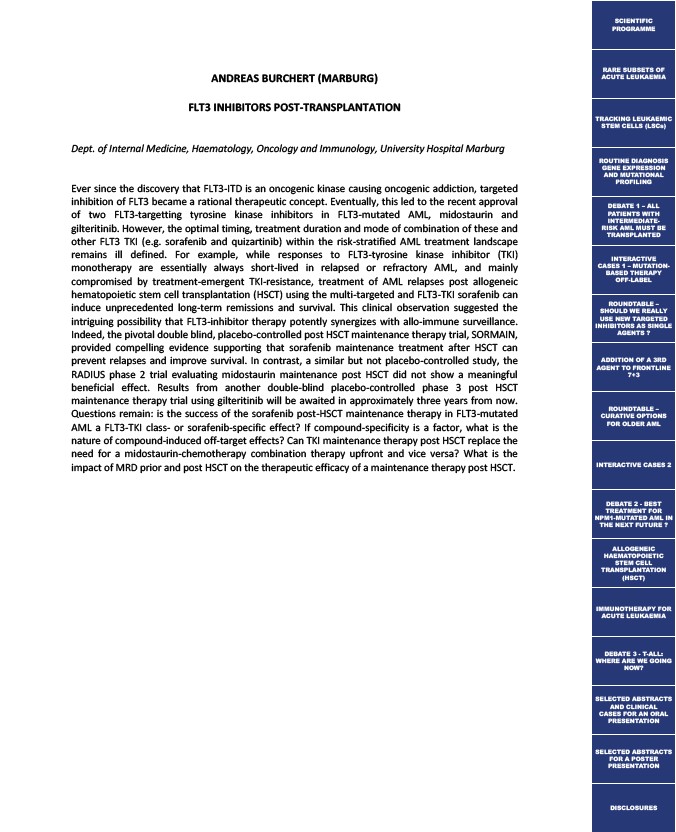
ANDREAS BURCHERT (MARBURG)
FLT3 INHIBITORS POST-TRANSPLANTATION
Dept. of Internal Medicine, Haematology, Oncology and Immunology, University Hospital Marburg
Ever since the discovery that FLT3-ITD is an oncogenic kinase causing oncogenic addiction, targeted
inhibition of FLT3 became a rational therapeutic concept. Eventually, this led to the recent approval
of two FLT3-targetting tyrosine kinase inhibitors in FLT3-mutated AML, midostaurin and
gilteritinib. However, the optimal timing, treatment duration and mode of combination of these and
other FLT3 TKI (e.g. sorafenib and quizartinib) within the risk-stratified AML treatment landscape
remains ill defined. For example, while responses to FLT3-tyrosine kinase inhibitor (TKI)
monotherapy are essentially always short-lived in relapsed or refractory AML, and mainly
compromised by treatment-emergent TKI-resistance, treatment of AML relapses post allogeneic
hematopoietic stem cell transplantation (HSCT) using the multi-targeted and FLT3-TKI sorafenib can
induce unprecedented long-term remissions and survival. This clinical observation suggested the
intriguing possibility that FLT3-inhibitor therapy potently synergizes with allo-immune surveillance.
Indeed, the pivotal double blind, placebo-controlled post HSCT maintenance therapy trial, SORMAIN,
provided compelling evidence supporting that sorafenib maintenance treatment after HSCT can
prevent relapses and improve survival. In contrast, a similar but not placebo-controlled study, the
RADIUS phase 2 trial evaluating midostaurin maintenance post HSCT did not show a meaningful
beneficial effect. Results from another double-blind placebo-controlled phase 3 post HSCT
maintenance therapy trial using gilteritinib will be awaited in approximately three years from now.
Questions remain: is the success of the sorafenib post-HSCT maintenance therapy in FLT3-mutated
AML a FLT3-TKI class- or sorafenib-specific effect? If compound-specificity is a factor, what is the
nature of compound-induced off-target effects? Can TKI maintenance therapy post HSCT replace the
need for a midostaurin-chemotherapy combination therapy upfront and vice versa? What is the
impact of MRD prior and post HSCT on the therapeutic efficacy of a maintenance therapy post HSCT.
SCIENTIFIC
PROGRAMME
RARE SUBSETS OF
ACUTE LEUKAEMIA
TRACKING LEUKAEMIC
STEM CELLS (LSCs)
ROUTINE DIAGNOSIS
GENE EXPRESSION
AND MUTATIONAL
PROFILING
DEBATE 1 – ALL
PATIENTS WITH
INTERMEDIATE-RISK
AML MUST BE
TRANSPLANTED
INTERACTIVE
CASES 1 – MUTATION-BASED
THERAPY
OFF-LABEL
ROUNDTABLE –
SHOULD WE REALLY
USE NEW TARGETED
INHIBITORS AS SINGLE
AGENTS ?
ADDITION OF A 3RD
AGENT TO FRONTLINE
7+3
ROUNDTABLE –
CURATIVE OPTIONS
FOR OLDER AML
INTERACTIVE CASES 2
DEBATE 2 - BEST
TREATMENT FOR
NPM1-MUTATED AML IN
THE NEXT FUTURE ?
ALLOGENEIC
HAEMATOPOIETIC
STEM CELL
TRANSPLANTATION
(HSCT)
IMMUNOTHERAPY FOR
ACUTE LEUKAEMIA
DEBATE 3 - T-ALL:
WHERE ARE WE GOING
NOW?
SELECTED ABSTRACTS
AND CLINICAL
CASES FOR AN ORAL
PRESENTATION
SELECTED ABSTRACTS
FOR A POSTER
PRESENTATION
DISCLOSURES